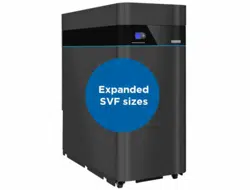Loading ...
Loading ...
Loading ...

Part number 550-100-252/0520
– 58 –
Figure 37 SVF
TM
NETWORK SETTINGS menu (see Figure 34, page 55 to access CONTRACTOR menu)
ROTATION AND SEQUENCE
Boiler Model, Altitude are critical settings.
Failure to set correctly could result in severe per-
sonal injury, death or substantial property damage.
1. Access contractor menus by pressing and holding the UP and
DOWN arrow keys at the same time for 7 seconds.
2. See Figure 34, page 55 for the screen sequences up to the
CONTRACTOR menu.
MENU ITEM PURPOSE
SEQUENCE TYPE
• Select the method of which the boilers will turn on and off.
Choose between SERIES, PARALLEL, or SMART. SERIES
sequencing allows each boiler to reach full input before
bringing on the next boiler in sequence. PARALLEL sequencing
uses a limiter, called BASERATE HIGH, to limit the firing
rate before adding additional boilers. SMART sequencing
(factory default setting) uses a low firing rate setting, called
BASERATE LOW, to keep boilers at a low firing rate, bringing
on additional boilers at reduced rate until all boilers are on if
necessary. Boilers are then allowed to modulate together as
high as necessary to meet demand.
BASERATE HIGH
• This sets highest modulation rate before turning on the next
boiler.
• This is read-only if in SMART mode.
BASERATE LOW
• This sets rate that the next boiler in sequence is going to turn
on when called.
• This is only visible if the Sequence Type is selected as SMART.
• It is recommended that Baserate Low be set at least 10% greater
than the Min Rate of any boiler on the network.
LEAD BOILER
ROTATE
• Choose how to rotate the boiler sequencing. Choose either
OFF, BY BOILER ID, TOTAL HOURS, or INCREMENTAL
HOURS. Firing sequence is changed every rotation period
(ROTATE FREQ – see setting explanation below).
• OFF — Master boiler is always the first to fire. Others fire in
the order of their network ID.
• BY BOILER ID — Lead boiler toggles in the sequence of net-
work ID numbers (changes from boiler number 1 to number
2, then boiler number 2 to number 3, etc.).
• TOTAL HOURS — The boiler with the most lifetime operating
hours is moved to the last in the firing sequence. The boiler with
the least lifetime operating hours is made first in the sequence.
Others are ordered by their respective lifetime operating hours.
• INCREMENTAL HOURS — Firing sequence is based on the
operating time during the previous rotation period. The boiler
with the least operating time is started first; the boiler with
the most operating time is started last; all others are started
in order of their operating time.
ROTATE FREQ
• Recalculates the boiler order every ## days based on LEAD
BOILER ROTATE setting.
FORCE LEAD
ROTATE
• Select YES or NO. When the rotation frequency timer expires
and the new order is calculated, this forces off the boiler low-
est in the sequence. Then the boiler highest in the sequence
fires to replace it.
CURRENT ORDER
• Shows the current firing order of the boilers on the network.
• This list updates based on how many boilers are detected and
the order of sequence based on the above settings.
• Sequence is shown as left-most boiler is first to turn on. Right-
most boilers are the first to turn off.
SVF
™
Series 1
COMMERCIAL CONDENSING GAS-FIRED WAT ER BOILER
— Advanced Manual
Screens shown above are typical
only. Actual screens depend on
control settings chosen.
Loading ...
Loading ...
Loading ...
